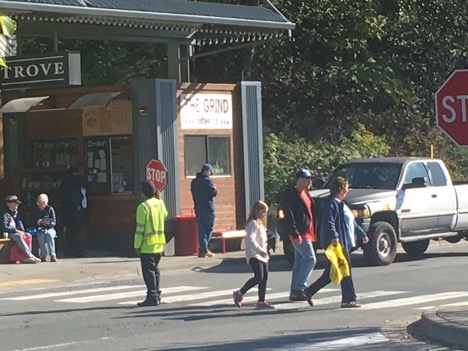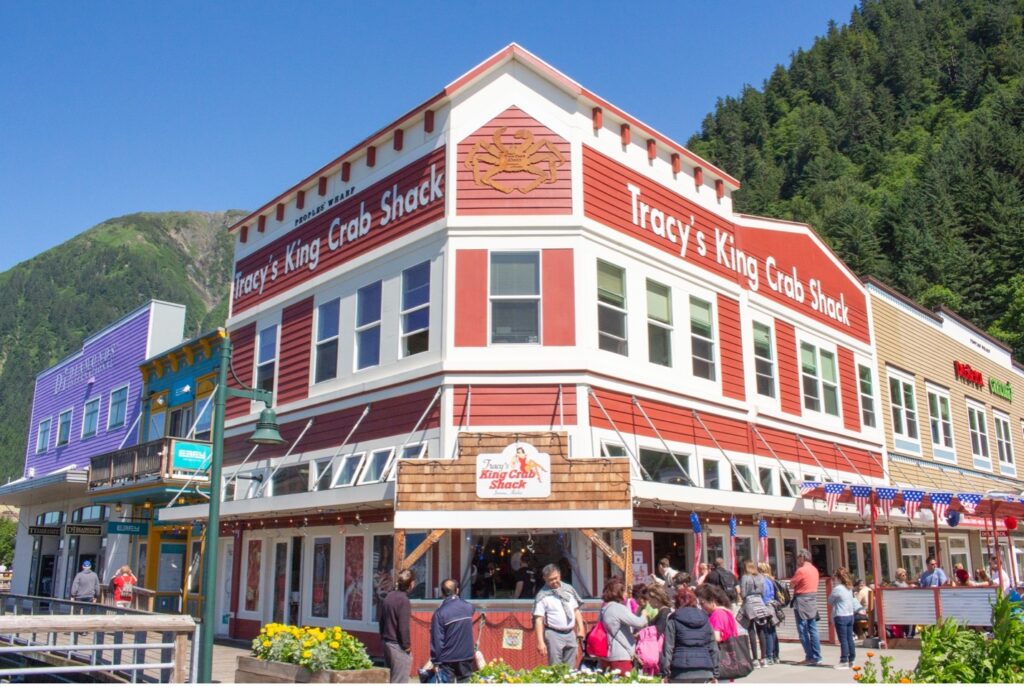By Vanessa Orr
When Alaska Native Heritage Center (ANHC) reached its silver jubilee this year, it chose to kick off a $25 million capital campaign. Investing a million dollars for each year of its past existence would let ANHC continue to educate visitors about Alaska Native cultures and strengthen community engagements for years to come.
Kelsey Ciugun Wallace, ANHC vice president of strategic advancement and communications, laughs as she recalls a totem pole raising and potlatch last October that attracted more than 1,000 people. “We were quickly reminded about how small our space was,” she says. “So when it came to celebrating our 25th anniversary, we decided to dream big and developed a four-phase capital campaign which is going to refresh our existing facility and expand our campus.”
The first phase, which included renovation to the Hall of Cultures and the Gathering Place, is now complete. The second phase entails renovation of the theater, and the third phase will lead to the construction of the healing garden. The fourth phase aims to build out the campus in Northeast Anchorage to create a large community gathering space and a subsistence kitchen.
The goal of Phase 1 was to breathe life into the Hall of Cultures and the Gathering Place. This revision to the public spaces brought out the excellence and beauty of Alaska’s Native peoples and cultures through enhanced exhibits and essential improvements.ANHC worked with its cultural advisory committees to provide a clear vision to Anchorage-based MCG Explore Design, which led to major renovations that were executed by Palmer-based Lake View General Contracting. The project had a $4 million budget, which was funded through grants from the Rasmuson Foundation, the US Economic Development Administration, the National Park Service, and several other supporters.
“The renovations really lightened it up… We also put new lighting and flooring finishes in the Gathering Place, which makes it feel grand as you walk in. It feels like a very high-end museum now.”
—Ray Kizer, President, Lake View General Contracting
“We took ANHC and MCG’s vision and design from drawings to reality,” says Ray Kizer, president of Lake View General Contracting. His company created a new feel in the Hall of Cultures by removing several windows, replacing the flooring, and installing new lighting and graphics to elevate the 6,000-square-foot space.
“The renovations really lightened it up,” he says of changes to the space originally designed in the ‘90s. “We also put new lighting and flooring finishes in the Gathering Place, which makes it feel grand as you walk in. It feels like a very high-end museum now.”
The Gathering Place also features new stadium seating to make it more accommodating for the community to use.
“It’s very common for us to host dance practices and Alaska Native Games practices, as well as other community events,” says Wallace. The new facility is available for rent for events ranging from community engagements to corporate gatherings.
New Hall of Cultures exhibits were guided by ANHC’s cultural advisory committees, who represent five major Alaska Native cultural groups.
“When we started fundraising several years ago, we began talking to our community—including artists, our elders, and our cultural advisory committees—to look internally at how we were presenting ourselves and whether the information we were providing was accurate to the needs and wants of our community,” says Wallace. “We took their input very seriously, and it affected every aspect of the design and its implementation.”
Exhibits to Share
The result is a space that embodies several Indigenous designs throughout, including the integration of traditional fabrics, furs, pelts, sealskin lamps, and a custom-made, one-of-a-kind carpet designed by Ahtna artist Melissa Shaginoff.
“We really looked at all of the aspects of the design—not just the photos and text on the walls—to ensure that the space was reflective of the beauty, creativity, and indigenuity of the Alaska Native community,” explains Wallace.
The exhibits themselves reflect many aspects of Alaska Native cultures and include displays of qayaqs and canoes made by master boatbuilders, traditional and medicinal spaces, and repatriated cultural artifacts.
“Nearly every week, we have boxes that arrive at ANHC filled with cultural objects and sacred artifacts that people are trying to give back to the community,” says Wallace, noting that people and institutions who have these objects and want to return them to their rightful place may not know how to do so.
One especially important addition, according to Wallace, is an exhibit interpreting the history of boarding schools and the effects that Native families and individuals feel to this day.
“To organize this exhibit, we have had to work with our community, cultural advisory committees, and staff to research and understand the traumas and impacts that affect family members who were forcibly assimilated at government- and church-run boarding schools,” she says. “We’ve created a safe space where our community can learn about this shared history.”
As the only center serving all Alaska Native cultures statewide, ANHC is the natural host for the boarding school exhibit.
“It is imperative that we create spaces for education and healing,” adds Wallace. “The time is now to address this complicated and challenging history.”
Five newly updated “identity galleries” showcase cultural artifacts, languages, cultural identifiers, and descriptions of Alaska’s Native peoples in each of the five major cultural regions. A mural depicts the different landscapes of each region as well. “Alaska is so geographically large that when it comes to the lands we each call home, it looks different in each cultural region,” says Wallace.
ANHC is currently fundraising to build more permanent exhibits, and it is now able to offer space for traveling exhibits as well.
A Challenging Timeline
Both the Hall of Cultures and the Gathering Place contracts were awarded on March 1, 2024, with the Hall of Cultures completed by Mother’s Day and the full project completed and open to the public on Father’s Day.
“One of the biggest challenges with completing Phase 1 was the timeline,” says Kizer. “But we worked as a team partner with ANHC and MCG to pull it off, and though it took long hours and some double shifts, we did it.”
He adds that it was also challenging to work in a building that was still in operation, and his team took special care to be aware of staff needs during construction. “We tried to treat the facility like it was our home,” he says of the project that created approximately forty jobs.
“I enjoy working on projects like this, which is why I am grateful to have worked on a number of projects for ANHC—I feel like it’s my way of contributing to the Alaska Native community,” Kizer says.
He most appreciates that the community can gather and visitors can learn about Alaska Native living and history. “That to me is more important than the job itself,” Kizer says. “Not a lot of building structures have the value and meaning that this does.”
Phase 2: Renovating the Theater
Phase 2 of the capital campaign is the ANHC theater renovation, funded by the M. J. Murdock Charitable Trust. Design is currently underway to incorporate immersive and emerging technology into the space, with construction slated for early 2025. The public can expect to be immersed in the cultures and lifestyles of rural Alaska in spring of 2025.
“In thinking about that space, we realized what an opportunity it could be to share our stories and broaden people’s knowledge of who we are as Alaska Native peoples by leveraging technology,” says Wallace of the space that currently houses an older screen, projector, and theater-style seating.
“This space will truly be transformational for ANHC, our community members, and guests visiting from across the world,” she adds.
The renovation will include an immersive space for viewing content specially developed for the theater. Visitors will be able to feel what it’s like to be surrounded by celebrants at a potlatch, to ride a boat up the Kuskokwim River, or to be at a fish camp. The new theater will also be available to local filmmakers and videographers who want to showcase their work through events like open projector nights and film screenings.
Phase 3: The Healing Garden
Phase 3 of the capital campaign focuses on the creation of a community healing garden, funded by the Mellon Foundation and the US Bureau of Indian Affairs. The center expects to engage in design this winter and is in the process of hiring a senior manager of community healing before construction begins.
“I enjoy working on projects like this, which is why I am grateful to have worked on a number of projects for ANHC—I feel like it’s my way of contributing to the Alaska Native community.”
—Ray Kizer, President, Lake View General Contracting
“As Alaska Native people, we walk with pretty heavy traumas, but we also walk with opportunity and an active practice of healing,” says Wallace, noting that the community is affected by both historical and current issues, from assimilative boarding schools to the blight of Missing and Murdered Indigenous Women.
“We understand the importance of having a space where our people can heal at their own pace, surrounded by the beauty and strength of our cultures, ceremonies, and the plants, land, air, and all aspects of the earth,” she adds.
The space will include cultural monuments built by artists, community members, and healers. The first two monuments were requested by the community: one dedicated to Missing and Murdered Indigenous Women and one dedicated to military veterans, as Alaska Native people and American Indians enlist in the armed forces at the highest rate of any ethnic group.
“Each monument will also have a ceremony practiced and documented alongside the creation and installment of the monument, which the center will memorialize with video, audio, and written documentation,” says Wallace. “Our elders who lived with knowledge from pre-contact practices are prioritizing sharing this critical information with us, so it’s important to work with them now to document these ceremonial practices to make sure that they are never lost.”
Phase 4: Community Hall and Subsistence Kitchen
Wallace, who is originally from Bethel, is especially excited about Phase 4, which will include the construction of a community hall and subsistence kitchen.
“As a Yup’ik person who has spent my whole life guided by our knowledge and teachings, language, songs, and dance, and being surrounded by hunting and fishing, I’m a product of my community,” she explains. “So I understand how important it is to have a space—whether a cultural center, school gym, or someone’s living room—where we can live to the fullest extent of who we are and where we come from and pass this knowledge on to our kids. Having spaces that are dedicated to the intergenerational transference of knowledge is so true to our people and so critical to who we are.”
Wallace recalls the shoulder-to-shoulder attendance at last October’s totem pole raising as evidence of the need for such a place. “Our community is so hungry for these spaces, and that need will just grow bigger and bigger,” she says.
“I understand how important it is to have a space—whether a cultural center, school gym, or someone’s living room—where we can live to the fullest extent of who we are and where we come from, and pass this knowledge on to our kids.”
—Kelsey Ciugun Wallace, Vice President of Strategic Advancement and Communications, Alaska Native Heritage Center
The community hall could also be used for facility rentals and likely even basketball games, says Wallace.
“As a leader in cultural tourism in Alaska, this will also give us more room to educate and facilitate spaces of sharing within the tourism industry and community and state organizations,” she adds. “We can share demonstrations on a larger scale and host different types of events that invite more to participate and learn about our people.”
Because subsistence is such a critical part of Alaska Native culture, a specially designed kitchen will allow community members to process fish and game and other gathered items.
“When we were recently prepping for a potlatch, we applied for and received a ceremonial moose hunt permit. When we brought the moose to ANHC, we were literally building tables so that we could respectfully process it,” says Wallace. “Because our subsistence way of life is consistently practiced by our people, we want to provide them with a clean, high-grade kitchen and processing center for use.”
ANHC is fundraising for Phase 4 and has already secured $1 million from Weidner Apartment Homes to support the community subsistence kitchen.
“We still have a long way to go,” says Wallace, “but we are confident that with the guidance and love of our community, capital campaign cabinet members, incredible industry leaders, and dedicated staff, we can do it.”
Reprinted by permission of Alaska Business Publishing
https://digital.akbizmag.com/issue/november-2024/25-million-for-25-years/


